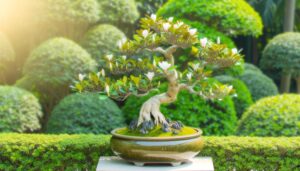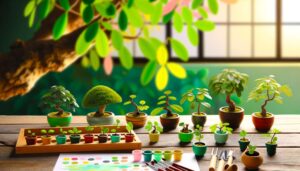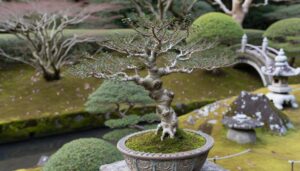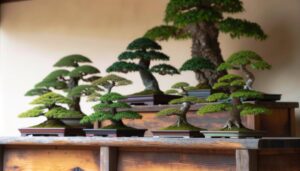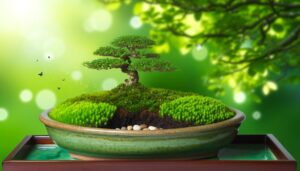Do Bonsai Trees Attract Bugs?
Bonsai trees do attract bugs due to their ideal microhabitats and humidity levels. Common pests include aphids, spider mites, and scale insects.
These pests thrive on the tree's sap and organic compounds, often leading to leaf discoloration, stunted growth, and branch dieback. Dense foliage and limited soil volume create favorable conditions for these insects.
Effective pest management requires regular monitoring, sanitation, and the use of natural deterrents like neem oil. Seasonal variations also influence pest activity, necessitating keen observation and timely intervention.
To explore more on how to maintain a pest-free environment for your bonsai, further insights are available.
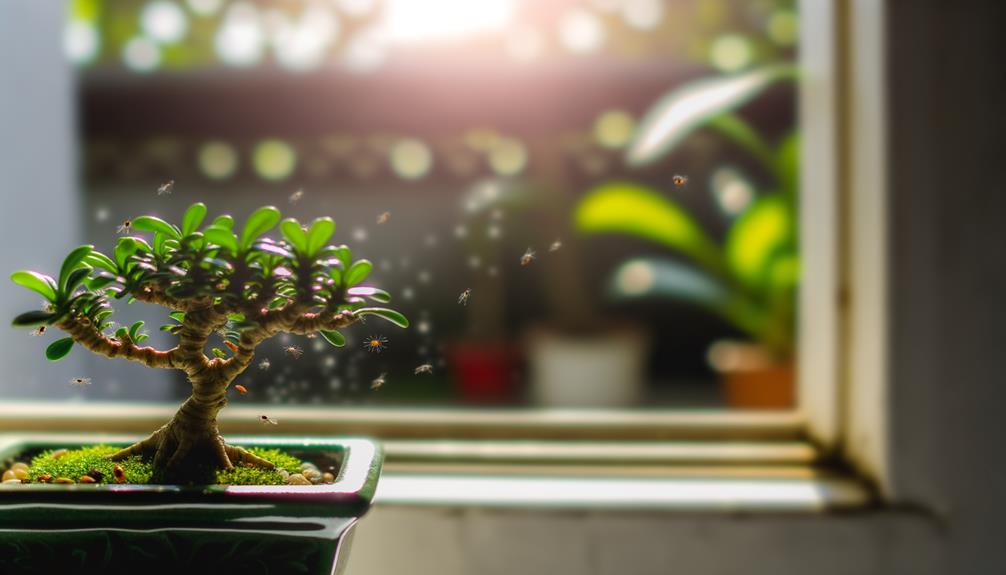
Key Takeaways
- Bonsai trees' humidity and temperature create ideal conditions for pest proliferation.
- Dense foliage in bonsai trees provides shelter for insects.
- The sap and organic compounds in bonsai trees attract pests.
- Limited soil volume in bonsai trees can lead to nutrient imbalances, attracting insects.
- Regular maintenance and natural deterrents reduce the likelihood of pest infestations.
Common Pests in Bonsai
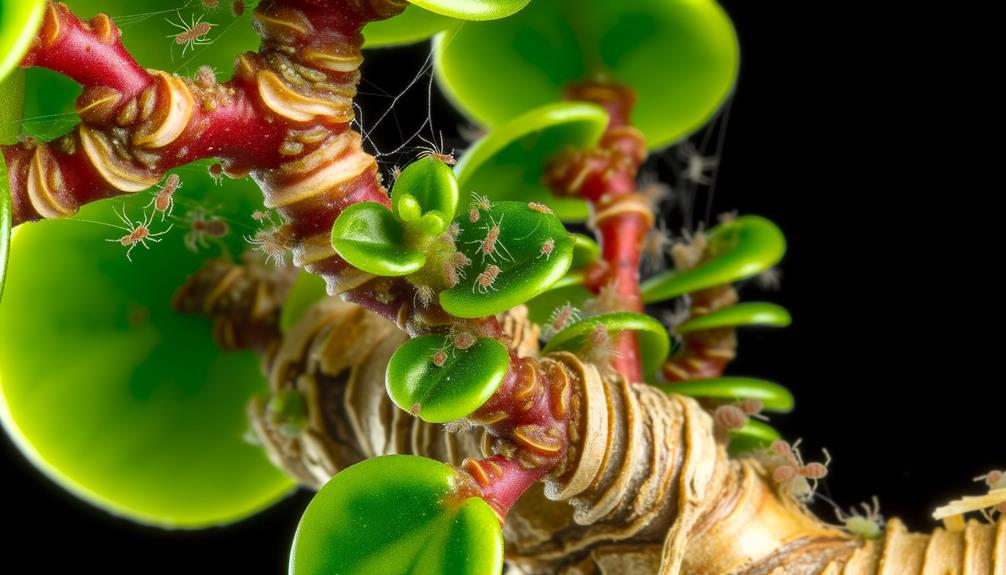
Among the various challenges faced by bonsai enthusiasts, the prevalence of common pests such as aphids, spider mites, and scale insects poses a significant threat to the health and aesthetics of these miniature trees.
Aphids, small sap-sucking insects, can cause leaf distortion and transmit plant viruses.
Spider mites, often found on the undersides of leaves, create fine webs and lead to discoloration and defoliation.
Scale insects, recognized by their protective waxy coverings, drain essential nutrients from the plant, causing stunted growth and branch dieback.
Effective management of these pests requires regular monitoring and appropriate interventions, including insecticidal soaps, horticultural oils, and biological controls.
This vigilance is essential to maintaining the vitality and visual appeal of bonsai trees.
Why Bugs Are Attracted
The attraction of bugs to bonsai trees can be attributed to the intricate interplay of environmental factors, plant characteristics, and the pests' biological needs. Bonsai trees, often kept in controlled environments, provide ideal humidity and temperature conditions conducive to pest proliferation.
The compact structure and dense foliage of bonsai create microhabitats that offer shelter and breeding grounds for insects. Additionally, bonsai trees can produce sap and other organic compounds that serve as food sources for various pests. The limited soil volume in bonsai pots can also lead to imbalances in nutrients and moisture, further attracting insects seeking sustenance.
Understanding these factors is important for bonsai caretakers to mitigate and manage pest infestations effectively.
Identifying Bug Infestations
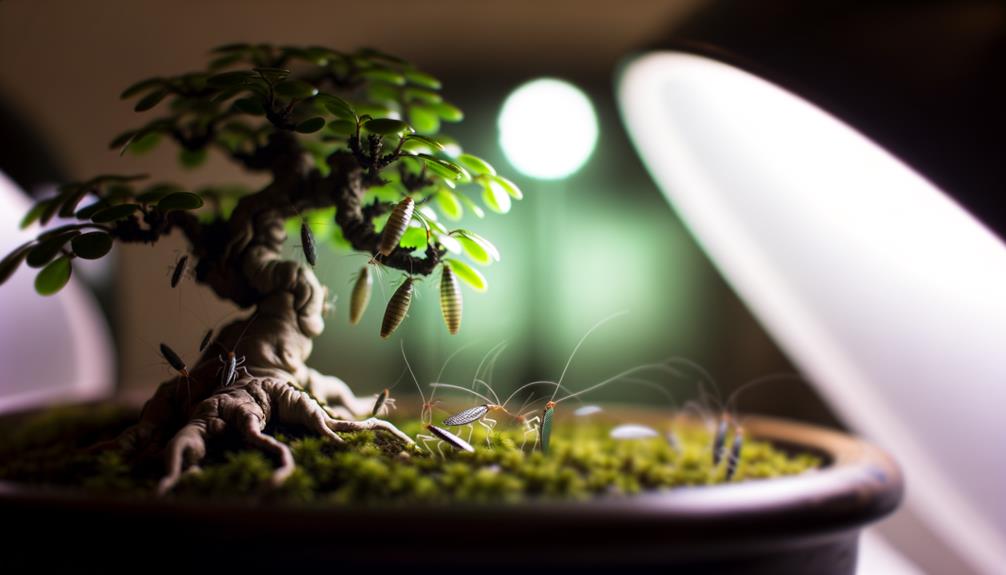
Identifying bug infestations in bonsai trees requires careful observation of common signs such as discolored leaves, stunted growth, and the presence of webbing or residue.
Effective pest identification methods include visual inspections, the use of magnification tools, and sometimes laboratory analysis to pinpoint the specific species.
Early detection and accurate identification are essential for implementing appropriate control measures and preventing further damage to the tree.
Common Infestation Signs
One of the primary indicators of a bug infestation in bonsai trees is the presence of discolored or damaged foliage, which can signal the activity of various pests. In particular, yellowing leaves or brown spots may suggest sap-sucking insects like aphids or spider mites.
Additionally, distorted or curled leaves often point to the presence of thrips or whiteflies. Another telltale sign is the appearance of a sticky residue, known as honeydew, left by insects such as scale or mealybugs.
Webbing on leaves and branches can indicate a spider mite infestation. Moreover, stunted growth or wilting, despite adequate watering, might hint at root-feeding pests. Recognizing these signs early is essential for effective pest management and maintaining bonsai health.
Pest Identification Methods
Accurate pest identification in bonsai trees typically involves a combination of visual inspections, magnification tools, and diagnostic tests to determine the specific type of infestation.
During visual inspections, one must carefully examine leaves, stems, and soil for signs of pests such as discoloration, webbing, or frass.
Magnification tools like hand lenses or microscopes can reveal minute details, such as aphid colonies or mite activity, that are not visible to the naked eye.
Diagnostic tests, including sticky traps or soil sampling, further aid in identifying elusive pests.
Understanding the specific type of infestation is essential for implementing effective, targeted treatments, thereby ensuring the health and longevity of the bonsai tree.
Preventing Bug Problems
Effective prevention of bug problems in bonsai trees hinges on implementing a regular cleaning routine and utilizing natural pest deterrents.
Consistent removal of debris and careful monitoring of the tree's environment can notably reduce the likelihood of infestations.
Additionally, employing natural deterrents such as neem oil or introducing beneficial insects can help maintain a healthy and pest-free bonsai.
Regular Cleaning Routine
Implementing a regular cleaning routine is essential for preventing bug infestations in bonsai trees. Regularly cleaning the foliage, branches, and soil surface can remove debris and potential insect habitats. Use a soft brush to gently clean the leaves, and periodically rinse the tree with lukewarm water. Inspect the tree for signs of pests, such as discolored leaves or webbing. Additionally, make sure that fallen leaves and organic matter are promptly removed from the soil surface to prevent decay and pest attraction.
| Task | Frequency | Tools Needed |
|---|---|---|
| Clean foliage | Weekly | Soft brush, water |
| Inspect for pests | Bi-weekly | Magnifying glass |
| Rinse tree | Monthly | Lukewarm water |
| Remove fallen leaves | Immediately | Hands, small rake |
This approach significantly reduces the likelihood of pest problems.
Natural Pest Deterrents
To effectively prevent bug infestations in bonsai trees, employing natural pest deterrents can be both an eco-friendly and efficient approach. Scientific evidence supports the use of botanical solutions to ward off common pests without harming the environment.
Introducing these natural deterrents into your bonsai care routine can markedly reduce the likelihood of infestations:
- Neem Oil: Extracted from the neem tree, neem oil disrupts the life cycle of insects, reducing their population.
- Garlic Spray: Allicin in garlic acts as a potent insect repellent.
- Peppermint Oil: Known for its strong scent, peppermint oil deters a variety of insects.
- Diatomaceous Earth: A natural powder that dehydrates and kills insects on contact.
Implementing these strategies ensures a healthy, pest-free bonsai environment.
Natural Pest Control Methods
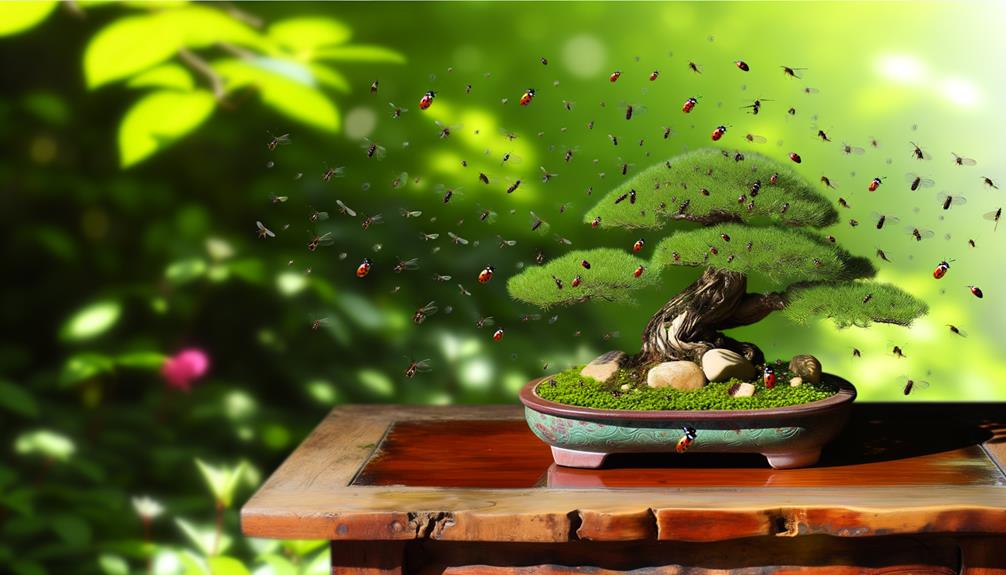
Utilizing natural pest control methods can significantly reduce the presence of bugs on bonsai trees without compromising their health or the environment.
Introducing beneficial insects, such as ladybugs or predatory mites, can effectively manage pest populations by preying on harmful insects.
Neem oil, derived from the neem tree, acts as a natural insecticide and can be applied to bonsai foliage to deter pests.
Additionally, horticultural soaps made from potassium salts of fatty acids disrupt the cell membranes of soft-bodied insects like aphids.
Regularly inspecting and maintaining proper hygiene around the bonsai tree, such as removing fallen leaves and debris, minimizes breeding grounds for pests.
These methods collectively ensure a balanced ecosystem, promoting the health and vibrancy of bonsai trees.
Chemical Treatments for Bugs
While natural pest control methods offer environmentally friendly solutions, certain situations may require the use of chemical treatments to effectively manage severe bug infestations on bonsai trees. Chemical treatments, including insecticides and miticides, can be essential tools in eradicating persistent pests. When selecting appropriate chemicals, it is important to take into account the specific type of pest and the potential impact on the bonsai tree.
Key factors to keep in mind for chemical treatments include:
- Active Ingredients: Choose insecticides with efficient active ingredients for the targeted pest.
- Application Frequency: Follow manufacturer guidelines on how often to apply treatments.
- Phytotoxicity: Ensure the chemical will not harm the bonsai.
- Environmental Impact: Opt for chemicals that minimize harm to beneficial insects and the surrounding environment.
Proper application guarantees optimal pest control and bonsai health.
Seasonal Bug Issues
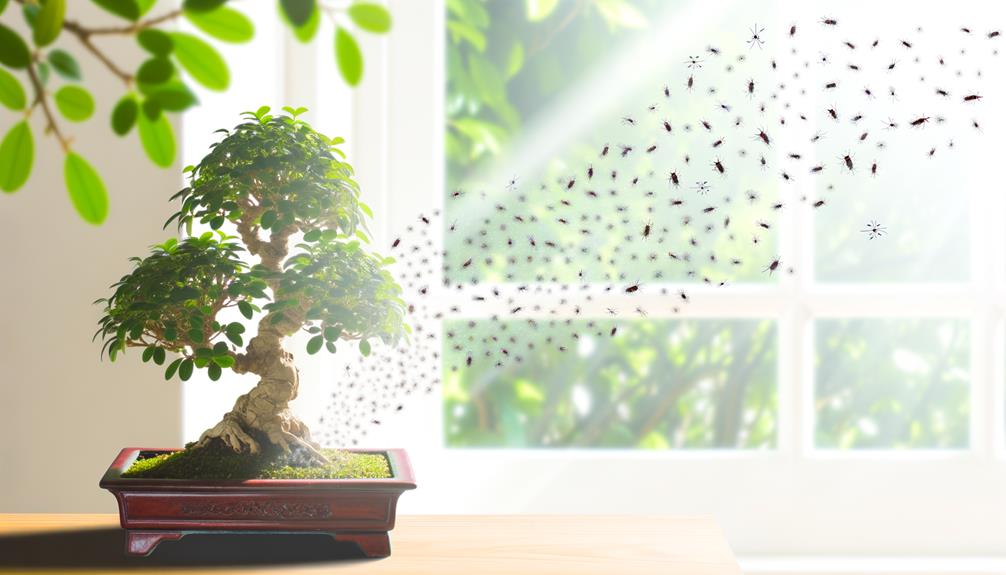
Seasonal changes greatly influence the types and prevalence of bugs that affect bonsai trees. During spring and summer, aphids, spider mites, and scale insects are particularly problematic due to increased temperatures and humidity, which create ideal breeding conditions.
In contrast, autumn and winter bring cooler temperatures and reduced daylight, slowing down the metabolic rates of many insects, thereby diminishing their activity. However, indoor bonsai trees may still encounter pests like fungus gnats due to stable indoor climates.
Regular monitoring and understanding the specific seasonal threats can aid in timely intervention, ensuring the health and longevity of bonsai trees. Consistent environmental adaptations, such as humidity control and temperature regulation, are critical in managing seasonal bug issues effectively.
Long-term Maintenance Tips
Ensuring the long-term health of bonsai trees requires a thorough approach that integrates proper watering, pruning, and pest control strategies. Regular maintenance not only fosters growth but also minimizes the risk of pest infestations.
Here are essential tips:
- Watering: Maintain consistent moisture levels but avoid waterlogging. Use a well-draining soil mix.
- Pruning: Regularly trim branches and roots to encourage healthy growth and airflow, which deters pests.
- Pest Control: Employ organic insecticides and introduce beneficial insects like ladybugs to control harmful pests.
- Repotting: Every 2-3 years, repot to refresh soil and check root health, which reduces the likelihood of pest colonization.
Conclusion
The prevalence of pests in bonsai cultivation is an omnipresent challenge, necessitating an arsenal of preventive and remedial strategies. Vigilant recognition and swift intervention are crucial to preserving the delicate balance of these miniature ecosystems.
Utilizing natural and chemical treatments alongside thorough seasonal upkeep can ward off infestation catastrophes. Mastery of these techniques guarantees the longevity and flourishing of bonsai trees, transforming potential pestilence into a sign of horticultural excellence.

